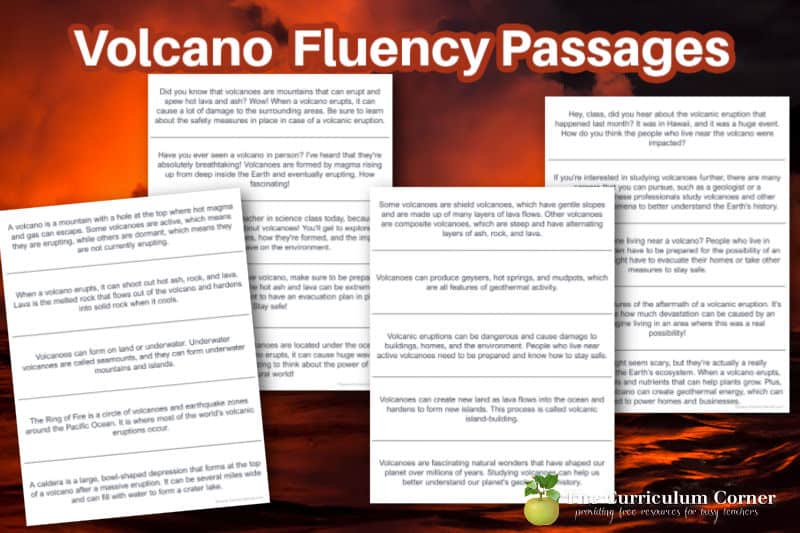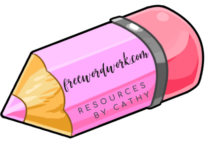These volcano fluency sentences are designed to give your children practice with fluency while they learn about volcanoes.
You can create your own set of volcano fluency sentences by using these printable strips.
This is another free resource for teachers and homeschool families from www.freewordwork.com.

Learning about volcanoes
The focus in my classroom on volcanoes began as we were studying Ancient Rome. Once we were to Pompeii, it seemed like a natural fit.
My students love digging into science topics during reading and this seemed like a great opportunity.
These sentences will help your students learn new facts about volcanoes. The passages include multiple sentences.
Volcano fluency sentences
| A volcano is a mountain with a hole at the top where hot magma and gas can escape. Some volcanoes are active, which means they are erupting, while others are dormant, which means they are not currently erupting. |
| When a volcano erupts, it can shoot out hot ash, rock, and lava. Lava is the melted rock that flows out of the volcano and hardens into solid rock when it cools. |
| Volcanoes can form on land or underwater. Underwater volcanoes are called seamounts, and they can form underwater mountains and islands. |
| The Ring of Fire is a circle of volcanoes and earthquake zones around the Pacific Ocean. It is where most of the world’s volcanic eruptions occur. |
| A caldera is a large, bowl-shaped depression that forms at the top of a volcano after a massive eruption. It can be several miles wide and can fill with water to form a crater lake. |
| Some volcanoes are shield volcanoes, which have gentle slopes and are made up of many layers of lava flows. Other volcanoes are composite volcanoes, which are steep and have alternating layers of ash, rock, and lava. |
| Volcanoes can produce geysers, hot springs, and mudpots, which are all features of geothermal activity. |
| Volcanic eruptions can be dangerous and cause damage to buildings, homes, and the environment. People who live near active volcanoes need to be prepared and know how to stay safe. |
| Volcanoes can create new land as lava flows into the ocean and hardens to form new islands. This process is called volcanic island-building. |
| Volcanoes are fascinating natural wonders that have shaped our planet over millions of years. Studying volcanoes can help us better understand our planet’s geology and history. |
| Did you know that volcanoes are mountains that can erupt and spew hot lava and ash? Wow! When a volcano erupts, it can cause a lot of damage to the surrounding areas. Be sure to learn about the safety measures in place in case of a volcanic eruption. |
| Have you ever seen a volcano in person? I’ve heard that they’re absolutely breathtaking! Volcanoes are formed by magma rising up from deep inside the Earth and eventually erupting. How fascinating! |
| Pay attention to your teacher in science class today, because you’re going to learn all about volcanoes! You’ll get to explore the different types of volcanoes, how they’re formed, and the impact they can have on the environment. |
| If you’re ever near an active volcano, make sure to be prepared for a potential eruption. The hot ash and lava can be extremely dangerous, and it’s important to have an evacuation plan in place. Stay safe! |
| Did you know that some volcanoes are located under the ocean? When an underwater volcano erupts, it can cause huge waves, known as tsunamis. It’s amazing to think about the power of the natural world! |
| Hey, class, did you hear about the volcanic eruption that happened last month? It was in Hawaii, and it was a huge event. How do you think the people who live near the volcano were impacted? |
| If you’re interested in studying volcanoes further, there are many careers that you can pursue, such as a geologist or a volcanologist. These professionals study volcanoes and other geological phenomena to better understand the Earth’s history. |
| Can you imagine living near a volcano? People who live in volcanic areas often have to be prepared for the possibility of an eruption. They might have to evacuate their homes or take other measures to stay safe. |
| Look at these pictures of the aftermath of a volcanic eruption. It’s incredible to see how much devastation can be caused by an eruption. Imagine living in an area where this was a real possibility! |
| Volcanoes might seem scary, but they’re actually a really important part of the Earth’s ecosystem. When a volcano erupts, it releases minerals and nutrients that can help plants grow. Plus, the heat from a volcano can create geothermal energy, which can be used to power homes and businesses. |
You can download these volcano fluency sentences by clicking on the blue pencil below. The sentences are divided into strips on four different pages.

